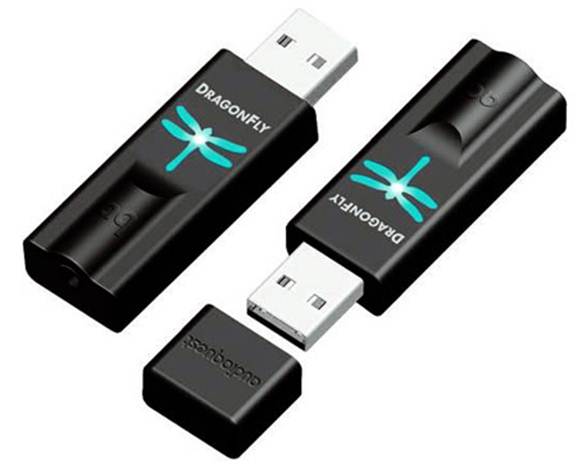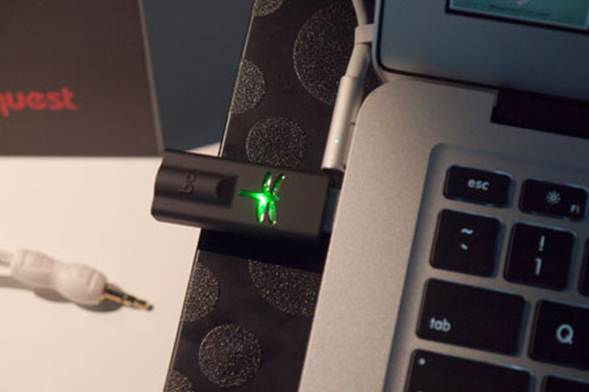When a manufacturer hands us a USB stick,
it’s usually crammed full of press releases or images of their latest wares.
But not the DragonFly. Crammed into this petite frame is not only a DAC (digital-to-analogue
convertor) but a headphone amp, too.
So, what does this mean for you? Well, you
can plug the stick into the USB socket of any computer (Mac or PC) and turn it
into a fully functioning hi-fi system – it’s as simple and elegant as that.

AudioQuest
DragonFly
First, though, you’ll need to go into your
computer’s audio setting and set it to output sound through its USB socket
(this is all explained in the DragonFly’s instruction booklet). Once it’s all
adjusted, plug a pair of headphones into the 3.5mm socket on the other end of
the stick and away you go. You’re now streaming music from your hand drive,
bypassing your computer’s DAC and using the high-grade convertor in the
DragonFly instead. Whether you’re a serious audiophile or a relative novice,
it’s ridiculously easy to use.
Top-notch design and execution
The DragonFly even piggybacks the volume
control of your music player’s software, so there’s no need for any external
volume knob – or any other controls. This allows both DAC and headphone amp to
be squeezed into such a small space; in the portability stakes, the DragonFly
takes some beating. You even get a small pouch in the box to protect that matt
finish.
File support is extensive: the DragonFly
can play up to 24-bit/96kHz audio files natively and can even handle those
hard-to-find high-res 24-bit/192kHz files, although these have to be
downsampled to 24-bit/96kHz during playback. To produce a more accurate sound
from your music files, the USB socket supports asynchronous data transfer (see Jargon
Buster, below).

It
might be small, but the DragonFly’s design, execution and presentation are all
top-notch
It might be small, but the DragonFly’s
design, execution and presentation are all top-notch. Despite the stick’s tiny
and delicate-looking exterior (it measures just over 6cm in length), it’s
actually quite weighty in the hand, while the classy finish feels smooth to the
touch. The logo lights up in different colours to indicate the type of file
being played (see Colours are calling, above).
In use, the DragonFly serves up an open,
spacious sound, packed full of detail. The difference between using this and
the headphone socket on an Apple MacBook Pro, say, is day and night.
Play something like Ludovico Einaudi’s
piano piece I Giorni to get started and each note sounds clear and purposeful.
Even when you make the jump down from a WAV version of the track to a 320kbps
MP3 rip, the DragonFly still breathes life into the compression, maintaining
the track’s impressive sense of graciousness and emotion.
Simply appealing
Switch to the opposite end of the musical
spectrum with some good old Guns N’ Roses and Don’t Cry, and there’s weight,
agility and solidity to drums, finesse to Slash’s fine axework, and the
DragonFly does a fantastic job of communicating Axl Rose’s gritty vocal tone
perfectly.
USB DACs are nothing new, but all the ones
we’ve seen to date are less portable than the DragonFly, even though some are
capable of producing excellent sound. It’s the simplicity of Audioquest’s
design and the quality of the sound here which take the appeal of this kind of
device to a new level. And this makes us quite excited for the future of hi-fi…
Colours are calling
The glowing dragonfly logo isn’t just for
show – it also lets you know the sampling rate it’s working at. Green is
44.1kHz, blue is 48kHz, amber is 88.2kHz and magenta is full-fat 96kHz.
Use it with
AKG
K451
These $120 portable on-ear headphones sound
the business.
Jargon
Buster: Asynchronous
The DragonFly features an asynchronous USB connection.
A DAC is likely to contain a clock that’s much more accurate than the one in
your computer. It tells the PC when to send data, rather than the computer
supplying it whenever it wants (usually inaccurately) – which means the timing
of the digital signal is far more accurate, and jitter levels (digital timing
errors) are lower. Theoretically, this means better sound quality.
|
Details
|
|
Price
|
$322.5
|
|
Ratings
|
5/5
|